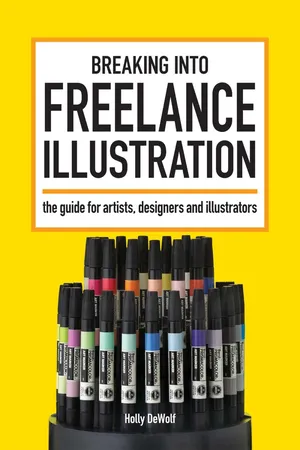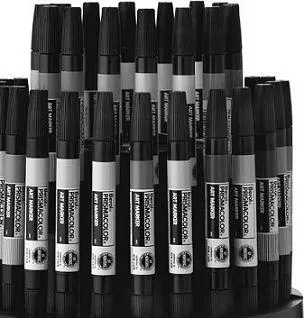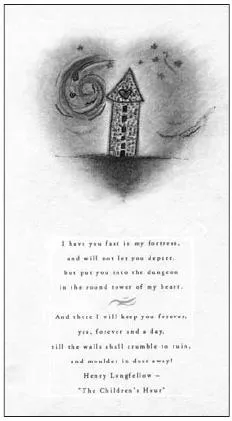
eBook - ePub
Breaking Into Freelance Illustration
A Guide for Artists, Designers and Illustrators
- 272 pages
- English
- ePUB (mobile friendly)
- Available on iOS & Android
eBook - ePub
About this book
Build Your Own Thriving Illustration Business
The boundaries between art, design and illustration are blurring, and with all the new opportunities for visual creatives, now is the perfect time to unleash your talent on the world!
Breaking Into Freelance Illustration provides a step-by-step roadmap for promoting yourself and running your creative business. You'll find up-to-date advice about best business practices, ideas for new promotional tools, answers to common questions and words of wisdom and inspiration from top illustrators.
This book shows you how to:
Full of industry insight, this book is a down-to-earth guide that fills in the creative business blanks. If you've ever wanted to moonlight as an illustrator, start a full-time business, or simply see your work published, this book will give you the information you need to make it happen.
The boundaries between art, design and illustration are blurring, and with all the new opportunities for visual creatives, now is the perfect time to unleash your talent on the world!
Breaking Into Freelance Illustration provides a step-by-step roadmap for promoting yourself and running your creative business. You'll find up-to-date advice about best business practices, ideas for new promotional tools, answers to common questions and words of wisdom and inspiration from top illustrators.
This book shows you how to:
- Set up a home office and balance your professional and personal life
- Create a professional portfolio and promote your work online
- Search out and negotiate with potential clients
- Create your own brand and work with an agent
- Develop a fair and accurate system for pricing your work
- Network within the creative community
Full of industry insight, this book is a down-to-earth guide that fills in the creative business blanks. If you've ever wanted to moonlight as an illustrator, start a full-time business, or simply see your work published, this book will give you the information you need to make it happen.
Frequently asked questions
Yes, you can cancel anytime from the Subscription tab in your account settings on the Perlego website. Your subscription will stay active until the end of your current billing period. Learn how to cancel your subscription.
No, books cannot be downloaded as external files, such as PDFs, for use outside of Perlego. However, you can download books within the Perlego app for offline reading on mobile or tablet. Learn more here.
Perlego offers two plans: Essential and Complete
- Essential is ideal for learners and professionals who enjoy exploring a wide range of subjects. Access the Essential Library with 800,000+ trusted titles and best-sellers across business, personal growth, and the humanities. Includes unlimited reading time and Standard Read Aloud voice.
- Complete: Perfect for advanced learners and researchers needing full, unrestricted access. Unlock 1.4M+ books across hundreds of subjects, including academic and specialized titles. The Complete Plan also includes advanced features like Premium Read Aloud and Research Assistant.
We are an online textbook subscription service, where you can get access to an entire online library for less than the price of a single book per month. With over 1 million books across 1000+ topics, we’ve got you covered! Learn more here.
Look out for the read-aloud symbol on your next book to see if you can listen to it. The read-aloud tool reads text aloud for you, highlighting the text as it is being read. You can pause it, speed it up and slow it down. Learn more here.
Yes! You can use the Perlego app on both iOS or Android devices to read anytime, anywhere — even offline. Perfect for commutes or when you’re on the go.
Please note we cannot support devices running on iOS 13 and Android 7 or earlier. Learn more about using the app.
Please note we cannot support devices running on iOS 13 and Android 7 or earlier. Learn more about using the app.
Yes, you can access Breaking Into Freelance Illustration by Holly DeWolf in PDF and/or ePUB format, as well as other popular books in Art & Art & Business. We have over one million books available in our catalogue for you to explore.
Information
PART ONE
GETTING STARTED
GETTING STARTED

CHAPTER 1
THERE WAS A HOLE IN MY EDUCATION
THERE WAS A HOLE IN MY EDUCATION
“The education of the will is the object of our existence.”
—RALPH WALDO EMERSON
Tell me if you’ve heard this one before: There once was a girl who graduated from art school. She had big plans, lots of talent and a portfolio. She stepped out into the world of work and tripped and fell on her face.
The concept was simple: I was to go to art school and then graduate into a career. So I went for five long, creative and expensive years. Many have applauded me for my dedication to my education. Others have asked me if I was nuts. Crazy or not, I left with many great skills and experiences. All I needed to do was change my direction a bit.
“Graphic design will save the world right after rock and roll does.”
—DAVID CARSON
I originally went to art school with the purpose of studying design. This was around the time Ray Gun magazine was created, as well as when the grunge era began. Design was being turned on its head again. Typography was intensely interesting, thanks to American designer David Carson—one of the most influential designers of the nineties, whose eye-catching magazine design and experimental typography centered around music, skateboarding and surfing. I could not help but be intrigued by it all. My new school’s traditional philosophies suddenly seemed stale. Rules were being broken. Computers were becoming an important tool for new ways of making design. Design seemed too clean for me. I needed an edge. The old ways were being altered, and so was my way of thinking.
“Never mistake legibility for communication.”
—DAVID CARSON

Illustration by Holly DeWolf
I could no longer fight my natural tendency to do things my way. Everything changed when I took a course named “Making Verbal and Visual Narratives.” The course was exactly what I had been looking for. It required painting, drawing and text. I was no longer a design student. I had chosen a new route—illustration.
BENEFITS OF ART SCHOOL
Despite the many challenges of attending art school, there were many good things that came my way:
1. Creative freedom
2. Access to equipment
3. Small class sizes
4. Access to a studio space
5. Help in stepping outside my comfort zone and self-sufficiency
6. Exposure to like-minded people
7. Critiques and helpful feedback
8. A trained eye and a trained hand
9. A portfolio I could use to show potential clients
10. A good background in art and design history
11. The ability to think conceptually
12. An understanding of the importance of deadlines
13. The idea of not having to live a nine-to-five life working for someone else.
There are, however, some things art school won’t teach you. Steven Heller (www.howdesign.com/dailyheller) wrote “Very simply, the truth is not always taught in art school—what is unspoken could fill volumes…” I couldn’t agree more. What I saw in my five years at school was that business seemed almost frowned upon. Often when I brought up questions regarding business to my professors, I was told their course did not cover that, but I could look into business classes elsewhere. To this day I believe business is a fundamental concept that should not have been missing from my education.
Here’s what illustrator Holli Conger has to say about her art school experience:
“Looking back, my first two years of college were very hard and very challenging. I had two really great instructors who pushed and inspired me to do great things. My last two years, not so much. I felt as though I wasn’t getting what I had gotten the first two years, so I had to make up for it on my own. I think my determination to learn and begin a freelance career (in graphic design) in my second year of college gave me the momentum I still have today. (That was ten years ago—wow, ten years. Hard to believe!) In my last year of school I did have a class that was geared toward promotion, but I didn’t really learn anything. I think my instructor didn’t really get it.
If I taught a class, it would have to be a class about promoting yourself as an artist, and I would be really hard on my students. They’d have to fight for that A. It is so important to know how to promote yourself. You can have all the talent in the world, but if you aren’t able to let people know about that talent, what good is it?”
Art schools should offer their students the complete package. When the artists who attend these creative institutions graduate, they should not leave the schools scratching their heads, wondering what paths to take when they come to those inevitable forks in the road. Business study— specifically for creatives (people who have the ability to create original and imaginative work)—should be a part of every art school’s curriculum. Unfortunately, this is not the case, so do your research carefully when choosing an art school and try to find one that provides you the necessary business skills. You’ll be glad you did.
Another downside is burnout. Art school can be contradicting sometimes because it can give you creative freedom, but then some classes actually stop the progression of that creativity. For me, this usually happened when I was told that things about my work were wrong or that my ideas were not good. How do you grade ideas?
Five years of fostering ideas, working on projects and a lot of studying took its toll. I needed a huge break after art school. I took three years off after I graduated and worked outside my field. I reeducated myself by researching the industry on everything I could get my hands on. I took business classes. I filled in the blanks.
Realizing that students need to be proactive about their education, I asked renowned illustrative designer and instructor Von R. Glitschka about the usual challenges of teaching illustration and what things he feels are left out in many art schools. Here’s what he said:
“The challenge, ironically enough, is getting the students to draw and refine their work. They, for the most part, don’t spend enough time on the conceptual end of things—sketching, brainstorming, etc.—so most of their final art lacks that unique or clever idea, though it may be rendered well. The first day of class, I always say to my students, ‘I can teach you good creative habits and a well-crafted creative process, but I can’t teach you how to be creative.’ I teach digital illustration, but many students are kind of shocked when I have them do drawing exercises. Regardless, if you want to be designer or illustrator, you should be a good fundamental drawer because this skill set will improve your ability to think through problems, visualize your ideas with more clarity and overall improve your level of work. A designer should never say, ‘I am a designer. I don’t draw.’ That to me is an oxymoron.
“The biggest problem I see in design schools now is they are churning out what I’d call ‘toolers’—students who know how to use tools well but don’t have a very well-defined creative process or ability to coherently work though a concept and refine it. It’s the pull-down menu generation, if you will. No one teaches ‘conceptual thinking,’ yet that is a core skill set needed, and many students fail to understand how to approach a project or how to think through ideas, weed out the bad ones and isolate the strong ones.”
Some new creatives are opting not to go to art school at all. The Internet and technology have made this easier with tutorials, how-to websites and software that encourage self-teaching and being self-made. Many creatives just don’t want to follow anyone else’s rules. Calling the shots is a new thing in illustration: Instead of listening to instructors, artists are creating communities for themselves that involve relationships with like-minded illustrators. These communities help many people land jobs when they are lacking in experience and are considered too young by some potential clients. Personally, I did both. I’m schooled and selfeducated. It worked for me.
THE ILLUSTRATOR’S ROLE
“Making money is art, and working is art and good business is the best art.”
—ANDY WARHOL
How does one become an illustrator? Do you choose the job, or does the job choose you? One thing is for sure: To be an illustrator, you need to know what the career entails. I once asked a class of illustration students what they thought the definition of illustration was. After a long pause, I got a few answers. I was told illustration wa...
Table of contents
- Cover Page
- Title Page
- Copyright
- Contents
- Introduction: Underdogs of the Art World
- PART ONE: GETTING STARTED
- Chapter 1: There Was a Hole in My Education
- Chapter 2: Home Is Where the Creativity Is
- Chapter 3: Show and Tell
- PART TWO: GETTING DOWN TO BUSINESS
- Chapter 4: Open for Business
- Chapter 5: At Your Service
- Chapter 6: Let’s Talk Numbers
- Chapter 7: Different Strokes for Creative Folks
- Chapter 8: Handling Problems the Creative Way
- PART THREE: GETTING INVOLVED IN THE COMMUNITY
- Chapter 9: Bring Your Talents to the Table
- Resources
- Acknowledgments: Kudos All Around
- Permissions